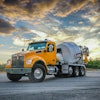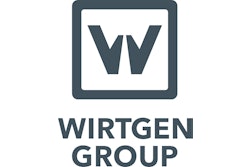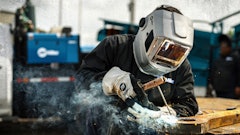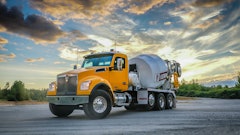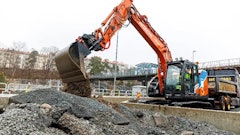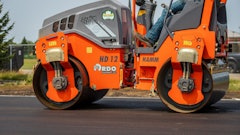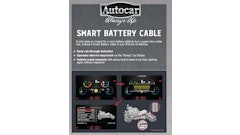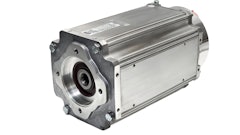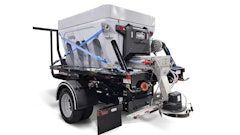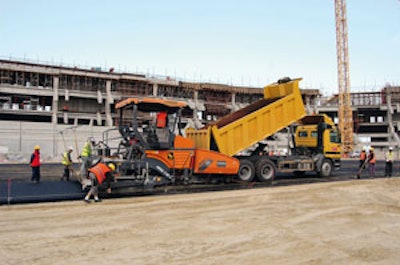
Construction of the new Formula 1 circuit in Abu Dhabi is a project which defies superlatives. While the battle for the 2009 world championship title is already raging and the winners of the first races being toasted, over 6,000 construction personnel are working flat out in the capital city of the United Arab Emirates (UAE) to complete the new high-speed circuit and its surrounding infrastructure. The "Abu Dhabi Grand Prix" in November will decide who becomes this year's world champion in the most prestigious international motorsport discipline. Right in the general bustle: VÖGELE pavers and HAMM rollers from German contractor Bickhardt-Bau. They shall provide for the perfect pavement both on the circuit and throughout the entire gigantic peripheral area.
The project schedule for the team from Bickhardt-Bau is extremely ambitious. The VÖGELE pavers and HAMM rollers were dispatched on their journey via container ship from Germany as early as in May 2008. After arriving in the Persian Gulf, the first task was placing base course and binder course. The surface course was scheduled to be paved in June 2009. A challenging workload, indeed, for the German road building team and the machines from the Wirtgen Group. The scope of the contract covers the 5.55km circuit, including pit lanes, paddocks and emergency roads, as well as all access roads and parking spaces. All told, the project in Abu Dhabi involves laying some 950,000 tons of crushed stone for base course and surfacing an area of 750,000m2 with 210,000 tons of asphalt.
SUPER pavers on the start line
Contractor Bickhardt-Bau has plenty of experience using pavers from VÖGELE and the paving team is well versed in their operation. In Abu Dhabi, the team is using two high-performance SUPER 1900-2 models combined with AB 600-2 TP2 Extending Screeds. These pavers have numerous features ensuring that the high requirement in terms of quality will be met. Indeed, the quality concept begins at the material feed stage: large, oscillating push-rollers provide that the material supply from the feed lorry into the paver is smooth - a key prerequisite for maximum surface evenness during paving.
AB 600-2 TP2 High-Compaction Screed provides ideal performance
It was the High-Compaction Technology of VÖGELE which laid the basis for a build-up of layers in Abu Dhabi. Especially for placing base and binder courses, Bickhardt-Bau relied on the high compactive effort of tamper and 2 two pressure bars installed in the VÖGELE High-Compaction Screed. In this configuration, the pavers yielded a pre-compaction of 92% and more.
Evenness is the prime quality criterion
"There are two main criteria for the quality of racetracks: the Polished Stone Value (PSV) of the pavement surface and the evenness. The Polished Stone Value is a measure for the resistance of the stone to polishing and is the decisive factor for the non-skid properties of the surface. This is primarily a question of the material used. As to evenness, however, this characteristic of the surface is produced by the pavers," explains Frank Dittrich, site manager of Bickhardt-Bau. The specifications are extremely demanding. The maximum tolerance allowed for evenness is 2mm measured over a distance of 4m in the longitudinal direction. "Thanks to the VÖGELE Grade and Slope Control Technology, we already reached the specified evenness to a large extent when placing binder course. And I know that also we'll achieve a perfect result with the surface course, due to our VÖGELE pavers," says Frank Dittrich.
VÖGELE sensors for highest pavement quality
The demands made on evenness increase from layer to layer. Bickhardt-Bau met the high requirements in terms of accuracy through the use of NIVELTRONIC Plus. They combined the VÖGELE System for Automated Grade and Slope Control with items from the range of VÖGELE sensors for a perfect match.
On the racetrack, 20m wide, base and binder courses were on the majority of sections paved in 4 strips of 5m each. When paving 8cm base course for the straights and wide bends, Bickhardt-Bau installed a tensioned wire on the outer side of the first strip. For the adjacent strips, they used the slope sensor combined with a Multiple Sonic Sensor tracing the previously paved strip. On the tight bends, a tensioned wire, traced by the Multiple Sonic Sensor, was used for all 4 strips.
Big MultiPlex Ski shows its strengths
The binder course was paved in three strips of 6.7m each. This marked the first major appearance of the Big MultiPlex Ski. "You really can't go wrong with the Big MultiPlex Ski. It's a fantastic solution," was the enthusiastic opinion expressed by foreman Horst Hennighausen on the sensor system from the wide range of VÖGELE products. He already supervised asphalt paving on the Bahrain and Shanghai race tracks. "The measuring concept enables the system to perfectly level out irregularities, all on its own." This is why Bickhardt-Bau also plans to make the most of the advantages offered by the Big MultiPlex Ski when it comes to paving surface course (for further information on the Big MultiPlex Ski, please refer to the "Tips & Tricks from Practical Applications").
Screed Assist helps achieve prime pavement quality in tight bends
The team from Bickhardt-Bau availed itself of another useful feature of VÖGELE pavers, especially when it came to paving on tight bends: the Screed Assist function. This function reduces the pressure exerted by the screed on the mix being laid. The Screed Assist pressure can be set separately for either side. In Abu Dhabi, this technology greatly facilitated laying base and binder courses in the inner areas of the tight bends. In some cases, an angle of 90° had to be paved in just 3m width. Consequently, the AB 600-2 Extending Screed was completely retracted and its weight rested on that narrow screed width. In this situation, the Screed Assist feature with infinitely variable pressure provides for the upfloat force necessary to support the floating of the screed.
During paving, the screed was assisted more on the inner sides of the bends than in the outer areas, as the screed receives less upfloat force on the bend's inner side due to the slower forwards movement. Thus, in this challenging paving situation, the AB 600-2 TP2 was able to float on the mix across the full pave width, thus making a significant contribution to the high degree of surface evenness achieved.
Special mix for racing circuits provides for a perfect grip
The best kept secret in the construction of racetracks is the composition of the mix, so that this is the only information available: on a crushed-stone base, 50cm thick and spread by graders, 8cm asphalt base (0/19) was paved. The binder course, laid in a thickness of 4cm, is aggregate with a maximum grain size of 14mm bonded with polymer modified bitumen. For the surface course, a "special mix for racing circuits" was used, based on aggregate with a grain size distribution of (0/11). Some 10,000 tons of granite from Malaysia and greywacke from England were shipped* to the Persian Gulf. The reason: when using the local construction materials, it would not have been* possible to obtain the specified friction coefficient - also referred to as Polished Stone Value - greater than 57.
Expert know-how required
The rules that apply to racetracks differ from those for conventional road construction. Geologist Jürgen Mika of Chemisch Technisches Laboratorium Heinrich Hart GmbH, Germany, has been on the job site in Abu Dhabi on a regular basis and knows the details: "If we had used the mix formula and grain sizes which are common practice here, we would have been unable to achieve the specified evenness for the binder course. However, after a few trials, we found a mix that gives a far higher degree of surface roughness. Furthermore, the material is considerably more stable during rolling. That was particularly important when compacting the tight bends."
Two pavers move in for the home straight
Paving work for the surface course was scheduled to begin in June 2009. In the area of the racetrack, the special mix will be paved "hot to hot". On the straights, two SUPER 1900-2 pavers are going to lay asphalt in 14m width. "In order to achieve the specified evenness and quality, we'll be operating at a speed of just 3m/min. when paving 4cm surface course," reports the foreman.
Extra compaction for the final density and sealing of the surface will be carried out by HAMM tandem rollers. For the team of Bickhardt-Bau and their high-performance VÖGELE pavers, a great deal of work still lies ahead until the job will finally be completed this summer. Nevertheless, everything indicates that the finish line will be reached according to schedule, despite the fact that weather conditions in the desert can be quite extreme at times. "We've already had to stop work on a number of occasions due to rain or sandstorms," says Frank Dittrich. Yet even he is certain that everything will be ready for the start of the prestigious Formula 1 event and that Sheik Mohammed bin Zayed Al Nahyan, Crown Prince of Abu Dhabi, will be able to proudly present the new racetrack to the world on time.

